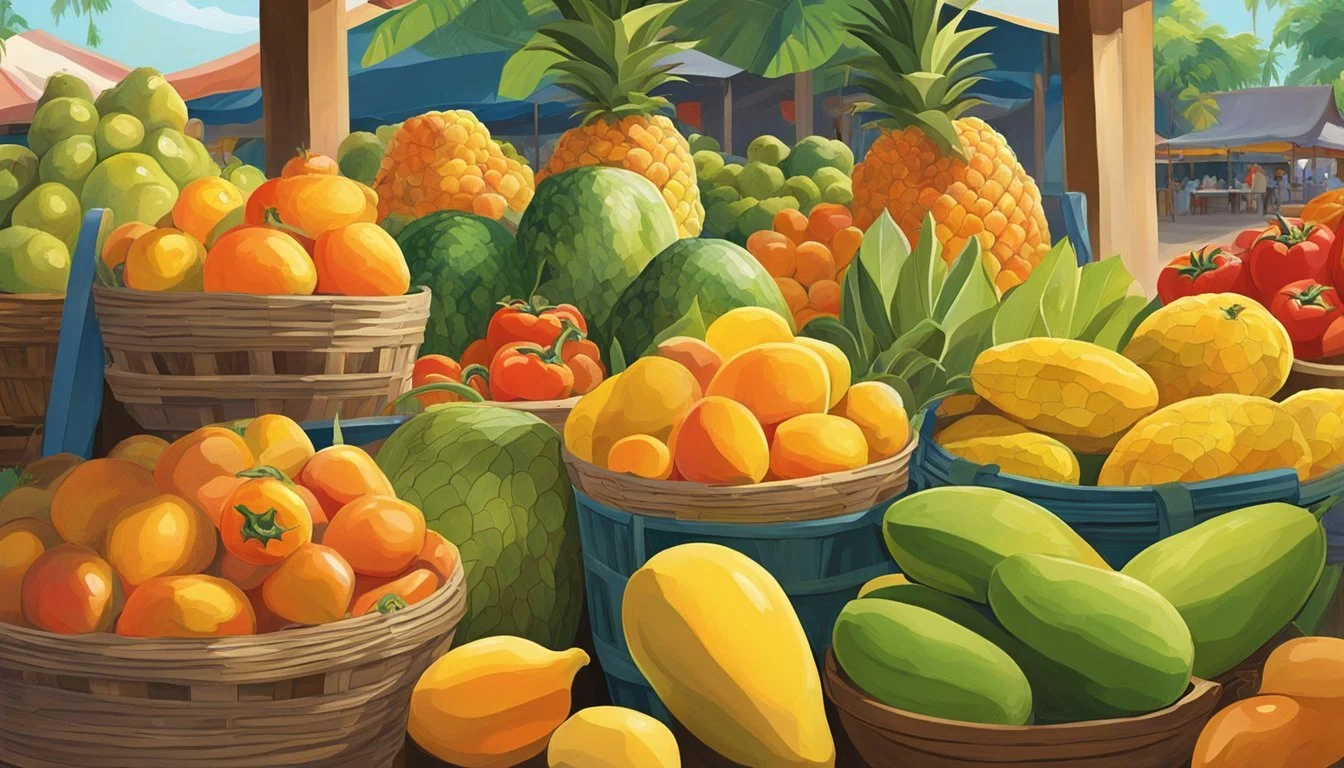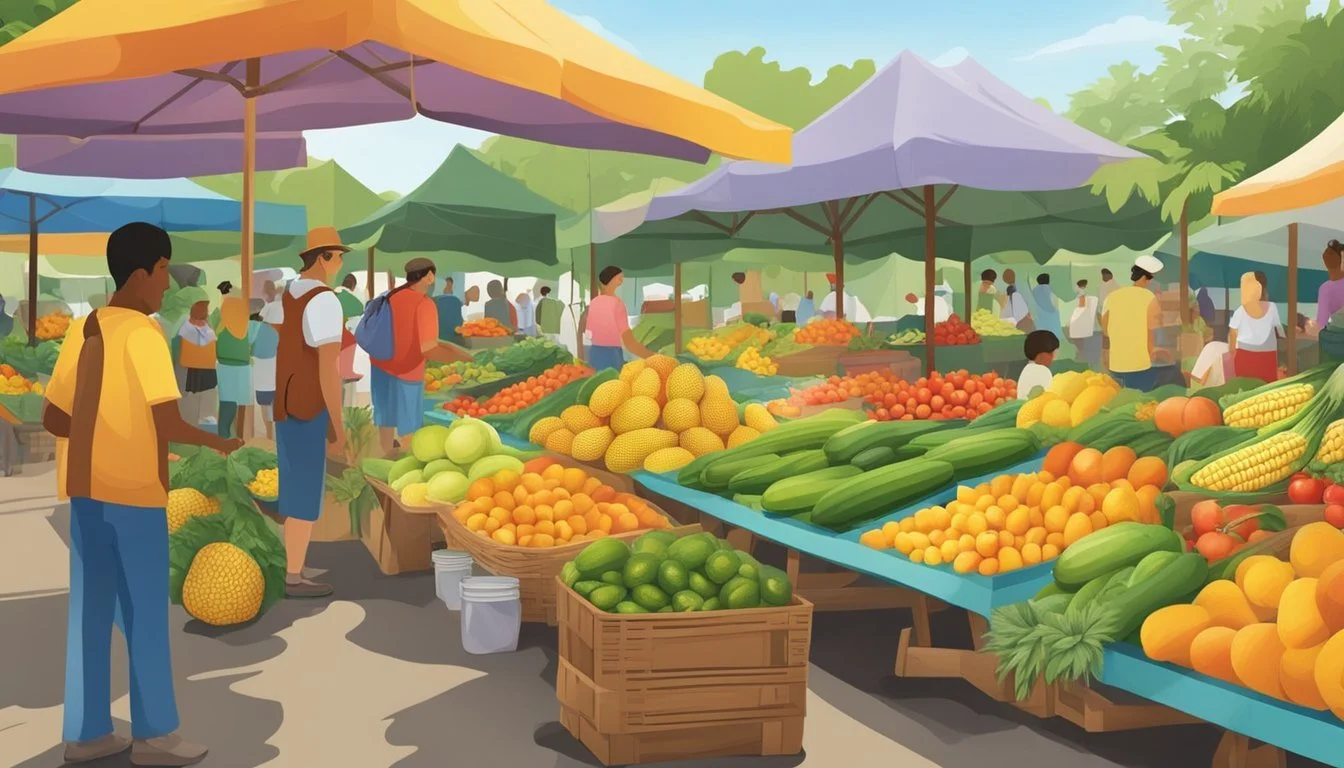Hawaii Seasonal Fruit & Vegetables in July
Your Guide to Fresh Picks
This Article is Part of our Hawaii Seasonal Fruit & Veg Calendar
July in Hawaii offers not just sunny beaches and tropical weather but also a bounty of fresh produce that is ripe for the picking. The islands' unique climate allows for a diverse range of fruits (What wine goes well with fruit?) and vegetables to flourish. Among these, visitors and locals alike can enjoy a variety of fruits such as the sweet and tangy apple banana, mangoes bursting with juiciness, and the much-loved pineapple renowned for its exceptional sweetness.
In addition to these fruits, July also marks a period where vegetables thrive in the Hawaiian climate. Traditional crops may not be indigenous to the islands, but Hawaii has embraced varieties with Asian influences, which often reach their peak during the summer months. These offerings from Hawaiian fields and orchards are not just a feast for the palate but also a testament to the islands' rich agricultural heritage.
Consumers have the opportunity to indulge in these seasonal delights direct from local farmers' markets or enjoy them as part of the diverse culinary experiences offered across the archipelago. This seasonal abundance ensures that Hawaii's food scene remains as vibrant and varied as its landscape.
Overview of Hawaii's Seasonal Produce in July
In July, Hawaii offers a unique blend of tropical climate and rich volcanic soil, providing a distinctive seasonal harvest.
Typical Weather and Growing Conditions
Hawaii's weather in July is typically warm with moderate humidity, creating an optimal environment for various produce. Daytime temperatures hover in the mid-80s Fahrenheit, while evenings are cooler. Regular rainfall patterns, especially in the windward areas, coupled with Hawaii's year-round mild climate, facilitate continual growth for a variety of fruits and vegetables.
Hawaii's Farming Landscape
Farming in Hawaii ranges from small family-run operations to larger commercial farms. These farmers adapt to the islands' microclimates, elevations, and soil types. In July, farmers in Hawaii are typically busy with the summer harvest. Hawaii is not dependent on the same growing seasons as the mainland, allowing for a unique farming schedule that can offer produce often out of season elsewhere.
Fruits in Season
In July, Hawaii's climate lends itself to a bounty of fresh fruit, with both common and exotic varieties thriving. Shoppers can find a vivid selection of tropical fruits reaching their peak ripeness during this time.
Tropical and Exotic Varieties
Mango: A highlight of the tropical fruit selection, Hawaiian mangoes are in full swing, boasting juicy, sweet flesh perfect for a refreshing treat.
Lychee: This delicately sweet fruit is typically found from May through September, with July still offering prime lychee that has a floral scent and a grape-like texture.
Rambutan: Similar to lychee, rambutan is another exotic option with a hairy exterior and a juicy, translucent interior. Although less common, they can be found during the summer window.
Hawaii also offers a selection of other tropical fruits during July:
Guava: This fragrant fruit is known for its juicy, sweet, and sometimes tangy interior.
Passion Fruit (Lilikoi): The tart and aromatic passion fruit is often at its best and widely available.
Starfruit: With a distinctive shape and crunchy texture, the starfruit provides both visual appeal and a tangy flavor.
Common Fruits and Their Peak Season
Pineapple: An iconic Hawaiian fruit, pineapple is sweet and tangy, available year-round but especially delicious in the summer.
Bananas: They are ubiquitous and thrive throughout the year, with locally grown varieties being smaller and sweeter than their imported counterparts.
Papayas: Another year-round fruit, papayas are especially succulent in the summer, perfect for a tropical breakfast or smoothie.
Coconut is a steady presence in Hawaii and can be enjoyed in various formats, from fresh coconut water to the rich meat within the hard shell. Each of these fruits contributes to the diverse and rich agricultural tapestry of Hawaii, making the summer a particularly rewarding time for fruit lovers to enjoy the local produce.
Vegetables Available in July
July in Hawaii is rich with an array of vegetables ripe for the picking. This mid-summer month brings a bounty of both root vegetables and leafy greens, each with a myriad of culinary uses.
Root Vegetables and Their Uses
Potatoes: In July, a variety of potatoes are readily available. They are versatile and can be used in anything from traditional Hawaiian stews to modern culinary creations like mashed potatoes or roasted potato salads.
Sweet Potatoes: Another staple, sweet potatoes, offer a nutritious alternative with a sweeter flavor profile. They are excellent when baked, made into fries, or incorporated into desserts.
Beets: Often used in salads for their earthy flavor and vibrant color, beets can also be roasted or juiced.
Leafy Greens and Salad Fixtures
Cabbage: Cabbage thrives in the Hawaiian climate and peaks in July. It's commonly used in salads, slaws, and as a key ingredient in the local dish luau stew.
Kale: Known for its health benefits, kale is a hardy leafy green that can be found in farmer's markets. It's often added to salads, smoothies, and sautéed sides.
Spinach: A versatile green, spinach is abundant in July and can be eaten raw in salads or cooked in a variety of dishes.
Lettuce: Various types of lettuce are in season, providing the base for many salad mixtures with their fresh, crisp texture.
In addition to these greens, July also sees a plentiful harvest of corn, cucumbers, and eggplant (What wine goes well with eggplant?), which can be found at local markets and are essential ingredients in summer recipes. Corn, sweet and tender, is perfect for grilling or adding into salads. Cucumbers provide a cooling crunch to dishes, and eggplants, with their meaty texture, are excellent when grilled, roasted, or stir-fried.
Selecting and Storing Produce
July in Hawaii offers a bounty of fresh fruits and vegetables, and understanding how to select and store them ensures they remain flavorful and nutritious from market to table.
Choosing the Freshest Fruits
When selecting fruits in Hawaii, look for those that are firm, indicating they are ripe and at peak freshness. For instance, avocados should yield slightly to pressure, but not be mushy. One should seek out fruits with vibrant color free of bruises or blemishes, which often signals a sweet and juicy quality. It’s essential to use one’s senses: a ripe fruit typically exudes a pleasant, noticeable fragrance.
Best Practices for Vegetable Storage
After choosing the freshest vegetables, optimal storage is crucial to maintain their quality. Most vegetables thrive in cool, not cold, environments away from direct sunlight to prevent wilting. For leafy greens, moisture control is key; they should be stored in a perforated bag with a paper towel to absorb excess moisture. Root vegetables, such as beets from the local markets, benefit from being stored in a cool, dark place, and should remain firm to the touch for an extended shelf life.
Preparing Hawaiian Produce
July in Hawaii brings a wealth of fresh produce to the table. With a focus on traditional and modern culinary applications, one can prepare Hawaiian fruits and vegetables in ways that honor the culture and cater to contemporary tastes.
Traditional Hawaii Recipes
In traditional Hawaiian recipes, the luau stands out as a culinary tradition that often features an array of Hawaiian produce. One might use exotic fruits such as mangoes, which are abundant in July, to create desserts like Mango Haupia, a beloved local treat combining the richness of coconut milk with the sweet, tangy flavor of fresh mangoes.
For savory dishes, taro leaves and stems are used in making Laulau, a quintessential luau dish, where one wraps and cooks pork and fish with the leaves, usually underground with hot rocks in an imu (traditional Hawaiian underground oven).
Modern Culinary Uses
Contemporary chefs in Hawaii often incorporate July's produce into modern dishes and drinks that reflect a blend of the islands' diverse culinary influences. Mangoes, avocados, and coconuts are particularly versatile and can be found in everything from fresh summer salads to innovative cocktails.
Drinks: Mixologists may use juicy mangoes to craft a refreshing Mango Martini or blend them into smoothies along with other tropical fruits. Coconut milk, another staple of the month, is often a base ingredient in various island-style beverages.
Desserts: Modern Hawaiian desserts draw from island ingredients to create unique offerings. July provides the perfect opportunity to utilize fresh mangoes in elegant tarts or coconut milk in Panna Cotta, infusing traditional Italian dessert with tropical flavors.
Where to Purchase
When looking for fresh produce in Hawaii during July, consumers can primarily explore local farmers markets or grocery store selections. Each provides a unique range of fruits and vegetables representing the local bounty.
Local Farmers Markets
Farmers markets across the Hawaiian Islands showcase an array of locally grown produce. Shoppers are encouraged to bring their own shopping bags or baskets to carry their purchases. In July, one can expect to find tropical fruits like mangoes and lychee, which are in season. Farmers markets not only offer fresh produce but also the opportunity to support local agriculture and learn about the origins of the food directly from the growers.
Available Produce: Mangoes, Lychee, Avocados
Shopping Tip: Arrive early for the best selection.
Grocery Store Selections
Grocery stores in Hawaii stock a wide variety of produce, albeit at different scales of locality and seasonality. They may import fruits and vegetables that are not in season locally to offer a consistent supply year-round. However, grocery stores also source from local farms whenever possible, especially for in-season items.
Available Produce: Pineapples, Papayas, Bananas
Local vs. Imported: Check labels for origin to support local produce.







